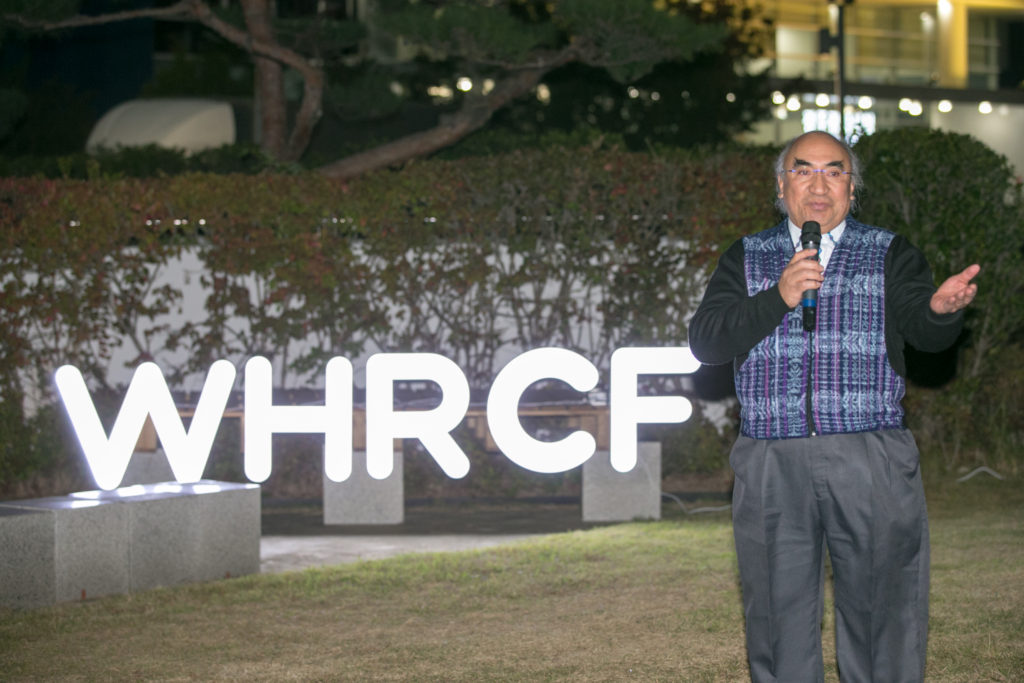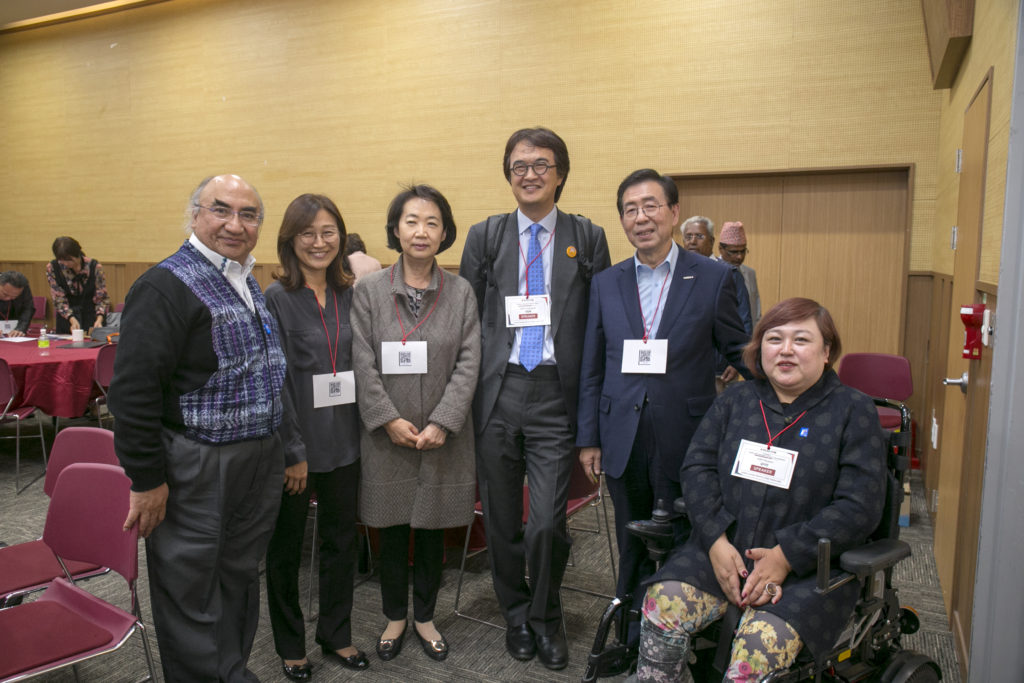Upholding Indigenous Rights and Combatting Racism in Guatemala and the Rest of the World: Exclusive Interview with José Francisco Cali Tzay
Written by Wilson Melbostad
Photographs courtesy of World Human Rights Cities Forum Secretariat
If you had the opportunity to drop in on the 2018 World Human Rights Cities Forum (WHRCF), which took place here in Gwangju during October 18–21 at the Kim Daejung Convention Center, you surely would have bumped into some truly influential characters in the human rights community. The forum, which is an annual and quickly developing tradition in our city, serves as a platform for practitioners from around the globe to discuss issues and the best implementation of human rights practices tailored to local municipal levels. I was fortunate enough to sit down with one of these influential actors, forum headline speaker José Francisco Cali Tzay from Guatemala. Though coming to Korea at a time when his country was actually in the early steps of treaty compliance review by the United Nations Committee on the Elimination of Racial Discrimination (CERD), a committee of which he is a standing member, Mr. Cali Tzay was participating in the WHRCF in an individual capacity. Cali Tzay believes that localized policies, particularly those surrounding education’s influence on racism, were absolutely critical in creating what he felt to be necessary culture shifts in global inclusiveness. However, in addition to his overlapping interests with the goals of the WHRCF, Cali Tzay’s story and teachings on indigenous peoples and issues of overall xenophobia are also something to behold, so we feel quite privileged to share them with you in this exclusive Gwangju News interview.
Gwangju News (GN): Please tell us a little about yourself and about the organization(s) you currently serve. I understand that you identify as Kaqchikel. Was your status as Kaqchikel integral in pursuing a career in the protection of indigenous peoples?
José Francisco Cali Tzay (Cali Tzay): First of all, thank you for the time. A little about my personal history: I am a Kaqchikel Mayan, just one of the 23 linguistic groups within Guatemala (with 22 of these 23 being different Mayan languages amongst which there are more than 100 dialects). Some people say today that we are half a million, but statistical studies show that there are around a million of us in Guatemala. At this moment here at the World Human Rights Cities Forum, I represent myself, actually, and I am here at the forum in an individual capacity. My aspirations to be a protector of indigenous rights started when I was about 13 or 14 years old (though unintentionally), when I started to get involved in the indigenous movements of Guatemala. Life was very peaceful when we were younger, as both Mayans and non-Mayans were all friendly with each other. However, once non-Mayan children began their studies and saw that we were different, even my old friends started to discriminate against us. It was quite a surprise to me, as I had never realized before that I was a person whose rights had to be actively defended in the first place. Other children would say, “Even though we’re poor, at least we’re not Indians.” We had to organize basketball and soccer teams on our own since we were not allowed to participate in our own school’s teams. Certainly, this experience of discrimination when I was younger inspired me to protect the rights of my people moving forward.
The group I became involved in was not supposed to be political but instead culturally focused in that we were trying to rescue our culture’s language, customs, dances, and overall traditions. Unfortunately, I now realize how naïve and young we were in those days, just children actually. What I mean by this is that we thought it was a good idea to conduct our public activities in Kaqchikel; what we did not know was that such activities could be understood as taking a political stance, specifically a position that was seen as questioning the status quo of the government. Ultimately, my participation in that group forced me to leave Guatemala in 1981 and live in exile for 14 years. I decided with my wife to come back to Guatemala with our five children in 1995, just a year and a half before the agreement between the military insurgents and the government took place. After returning, I began work in various human rights organizations, and from there, we started to defend not only human rights activists but also to speak about indigenous people’s rights. This was a continuation of the work I had pursued in exile, as I had become a part of the international indigenous movement. I first arrived in Geneva in 1985 and participated in the World Council of Indigenous Peoples, and from that time, I started to get more in touch with other international movements of indigenous peoples.

GN: From what I understand, indigenous Mayans make up about half of the population of Guatemala, but rights campaigners say they face extreme inequality. Can you explain to our readers, who might not have a solid grasp of Guatemalan affairs, about the civil war or what the situation is like today for indigenous peoples in the country?
Cali Tzay: It is somewhat funny to mention this, but multiple anthropological studies cite that the beginning of the civil war in Guatemala can be traced to the American counter-insurgency training program of Guatemalans in the 1950s. The Americans were deathly afraid of having a repeat of the post-WWII massacres in the Philippines, so they went out of their way to bring local Guatemalan authorities and military personnel over to the States in order to train them in protecting against any type of communist insurgency. Yet what happened instead was that once these trainees were sent back to Guatemala and dispatched to the countryside, they began utilizing their new weaponry skills against their own people. It was these trainees who became the guerilla insurgent forces during the civil war.
The war was long and bloody; more than 250,000 people were lost on both sides. The Mayans fought on both the side of the government and that of the insurgents, as they were forced to pick between two evils in order to survive. Despite the fact that it was a war that most Mayans did not want, most of the battles consisted of almost 100 percent Mayans since they were strategically placed on the frontlines. The peace agreement in 1996 stopped the fighting, and though the agreement was quite an advanced document, as my wife always says: It is people, rather than a piece of paper, who hold the power to implement it. The reality is that the agreement’s portions on recognition of indigenous peoples in Guatemala, though comprehensive from a textual standpoint, have been hardly implemented in practice. Structural racism and the political persecution of the Mayans is still rampant, and political willingness is greatly needed.

GN: You were elected as a member of the CERD in 2004 as the first and only indigenous member of a UN treaty monitoring body. Can you talk about what it was like participating within the UN treaty body system? Did you find yourself more often encouraged or discouraged by the information you learned in the CERD proceedings?
Cali Tzay: Sometimes what I see in the CERD discourages me, but many times I have been encouraged to continue. Small changes keep me going. For example, in Peru, the Philippines, and also in Ecuador, the CERD has given suggestions for how to better protect indigenous peoples. I am not saying that indigenous peoples there are living in heaven, but now in these countries’ constitutions and laws these peoples’ rights are recognized. Another example I point to is the Western Shoshone tribe in the U.S. There, the CERD condemned the government for committing environment-related racism against the tribe for over six years. Of course, I am not saying that the UN will solve all the world’s problems. The UN is a governmental institution based on the states who are members of it. But all the instruments stipulated by the UN are only tools and political instruments for civil society and for indigenous peoples. Case in point, an attorney from the Western Shoshone took the CERD’s decision to Washington, D.C., and lobbied against some of the companies exploiting uranium and other minerals on their territory. After speaking with government reps and leaving a copy of our report, many of the extraction companies retired from the area. Stories like these keep me going and force me to continue this work.

The former high commissioner for human rights recently pointed out that though we have been making great advancements in fighting racism in the world, unfortunately, racism has also become more advanced and sophisticated than ever before. I would also add to this that the practice of racism has become cynical. You do not need to hit someone physically to practice racism; by only looking at someone in a particular way you can express racism. Racism needs to be continuously fought, as it is quickly becoming the worst illness of human beings in this era: Those who believe there exists a superior race clearly suffer from psychological illness. The reality is that there is only one race, and that is the human race.
GN: Maintaining one’s indigeneity against the backdrop of our globalized world is becoming more and more difficult for many. Media and globalization have been a blessing and a curse in the sense that they have greatly opened up the rest of the world to everyone, while also providing clashes in culture to the foundations for moral values, beliefs, and customs. What do you say to people who believe that, while protecting culture is important, cultural change and cultural homogenization in our globalizing world is inevitable? Is there a specific balance that can be struck?
Cali Tzay: Culture is not static or permanent. Everything changes, even a stone changes. Thus, cultures also change simply with the passing of time. I hear arguments that to be “indigenous” your culture has to go back at least 500 years, yet culture is fluid and dynamic and can never be encapsulated in such a way. The cultures of indigenous people under colonialism adjusted to fit the needs of survival, thus I do not believe there is such a thing as a pure indigenous culture. Perhaps the closest thing to this ideal would be the uncontacted tribal communities deep in the jungles of Brazil, yet everyone else has already mixed and been subjected to great transformations up to now. However, in saying that, we as the human race do have the right to identify as indigenous. Additionally, a community has the right to reject or to accept one’s identification as an indigenous person. We have to continue to discuss how to identify as a group. For example, the Kaqchikel language is a base for being part of the Kaqchikel people. By contrast, the Q’eqchi’ group in Guatemala lost their language but are still proud to identify as Q’eqchi’, and no one can say they are not Q’eqchi’ just because they do not have their language preserved. The ultimate lesson is that every group has the right to set up its own parameters; however, in doing so the membership of a particular group should never serve as a basis to claim superiority or act as a measuring stick for participation in a particular society. This, of course, is the delicate balance between racism and respect for indigeneity, and it is an imperative lesson for Korea and all nations to learn if we are to truly coexist peacefully as human beings.
The Author
Wilson Melbostad is an international human rights attorney hailing from San Francisco, California. Wilson has returned to Gwangju to undertake his newest project: the Organization for Migrant Legal Aid (OMLA), which operates out of the Gwangju International Center. He has also taken on the position of managing editor of the Gwangju News.







